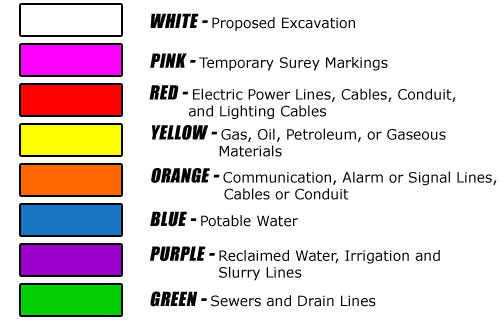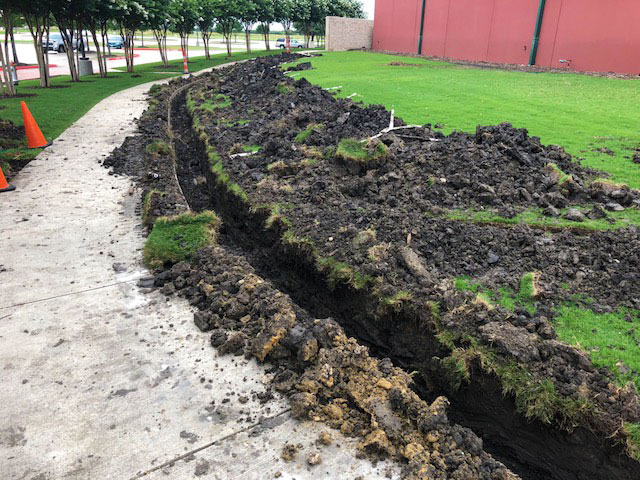Planning to dig? Beware of buried utilities!
A recent report by the Common Ground Alliance (CGA) states that Americans strike underground utilities approximately once every minute. Apart from the risk of serious injury, unintentionally damaging buried utility causes interruption of service as well as a lot of time and expense to put everything right.
 Assuming you survive the gas explosion, electrocution or flood (or all three) you could face a hefty fine and some frosty glares from your neighbors.
Assuming you survive the gas explosion, electrocution or flood (or all three) you could face a hefty fine and some frosty glares from your neighbors. To make matters worse, many homeowners plan to stay in their current homes this year, rather than sell in an uncertain market, and, according to a survey cited by the CGA, 81 percent said they would take on some form of home and/or landscape improvement. Additionally, 40 percent said they “planned to dig more” this year than in the previous twelve months.
The survey also found that 63 percent would choose to take on their own digging projects, rather than hire a professional contractor. In rural areas, that number climbs to 74 percent of homeowners.
So what does this mean to you?
Should you abandon your plans to plant those dogwood trees or build that shady arbor you’ve always promised yourself? Certainly not! There’s never been a better time to upgrade your landscape, whether you’re planning to stay and enjoy the fruits of your labor or to increase the curb appeal of your house in a tough real estate market.
But you DO need to know where those underground utilities are before you dig. And some can be a lot closer to the surface than you might think.
And for once, the solution really is remarkably easy. There is a single three-digit phone number you can call from anywhere in the United States. That number is 811.
The “call before you digs” number is free and will be routed to your local utility companies. They, in turn, send out a professional locator to mark the location of utility lines on your property. Again the service is free.
May has been designated Safe Digging Month to celebrate the first anniversary of the launch of the 811 programs. Among the recommendations from the CGA:
Always call 811 before digging, regardless of the depth or familiarity with the property.
Tell neighbors, co-workers, family, and friends about 811 if they discuss their plans for an outdoor home improvement project with you.
 Plan ahead. Call on a Monday or Tuesday for work planned for an upcoming weekend, providing ample time for all lines to be marked.
Plan ahead. Call on a Monday or Tuesday for work planned for an upcoming weekend, providing ample time for all lines to be marked. Avoid starting projects until you’re sure all lines are marked. Confirm that all lines have been marked by contacting your local one-call center.
If you do decide to use a contractor, be sure to ask them to confirm that an 811 call has been made.
You can find out all you need to know at www.call811.com it might be a good idea to write “811” in big letters on a card and tape it over your digging tools in your shed or garage!
So you’ve called 811, your utilities are clearly marked. What to plant?
Red Bud ForestPansy
This is a really attractive ornamental tree that is perfect for a small garden, with deep maroon color lasting all summer long. Blooming in early spring, it prefers full or partial sun and well-drained soil.
This is a really attractive ornamental tree that is perfect for a small garden, with deep maroon color lasting all summer long. Blooming in early spring, it prefers full or partial sun and well-drained soil.
Japanese Maple
These beautiful maples are quite versatile, looking good as a specimen multi-stem shrub, a small tree or in plant groupings. A good choice for an urban setting as they tolerate crowding from other plants and don’t mind the lack of full sun.
These beautiful maples are quite versatile, looking good as a specimen multi-stem shrub, a small tree or in plant groupings. A good choice for an urban setting as they tolerate crowding from other plants and don’t mind the lack of full sun.
So dig away, but call 811 before you do!
Question: Jimmie, I planted some new Salvia last spring and took off immediately and was doing wonderfully. I cut it back last fall and it came out this year and looked liked it was going to do well again and then it seemed to stop blooming all together? What can I do to get more blooms again? Thank you for your time. Janet P. in Mckinney.
Answer: Hi Janet, The slowdown on your blooming Salvia is pretty normal. Very few perennials actually bloom no more than 3-4 weeks a season. Your plants will look better and bloom longer if you cut them back by about 50 percent sometime around February. This will promote a lot of new growth and blooms. I would also cut them back again by about 25 percent in early August to reshape them before the fall bloom again.
Until next time…Happy Gardening!!
